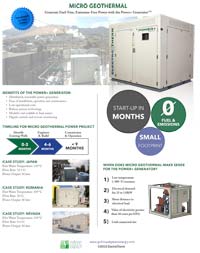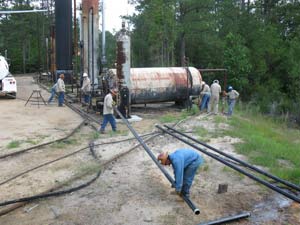Until recently, geothermal power generation was synonymous with high cost geothermal power plants that are focused on technologies in the multi-megawatt range. Well, no longer.
GCGE is the first to successfully generate electricity from a much smaller heat source. We installed an ElectraTherm Power+ GeneratorTM in Mississippi on a Denbury Resources producing oil well. The hot “produced water” that comes with the oil is separated and directed to the Power+ GeneratorTM which produces power to offset the power used to dispose of the produced water. The demonstration project was made possible by the contribution of the well by Denbury, known in the O&G industry for their leadership in new and cutting edge technologies. The Research Partnership to Secure Energy for America (R.P.S.E.A.), premier oil and gas industry researchers, matched GCGE with the dollars for the demonstration project.
There are 3 gigawatts of power in just 8 U.S. states that are ready for the taking from over 823,000 oil & gas wells in the U.S. And, the vast majority of these wells produce small amounts of water that are just right for us to produce enough power for up to 65 homes from each well…year ‘round. This is emission and fuel free power.
This Denbury Resources oil well produces at 9,500 ft. under geo-pressure and produces 100 BOPD and 4000 BWPD (116 GPM at 98% water). The surface flowing temperature is 200°F, so low that power production has been thought impossible….until now. The electricity produced from this waste water is displacing $.098 power at an effective cost of less than a half cent. And projects like this qualify for a 30% Investment Tax Credit from the IRS, further reducing the project cost.
Scientists in SMU’s Geothermal Lab, where the Power+ GeneratorTM was first tested in a commercial environment, see a natural partnership in co-production of geothermal energy from oil and gas wells. Large quantities of water are produced with the extraction of oil and gas, either because it was present in the reservoir before drilling, or because water was injected into the formation to force oil and gas to the surface.

Historically, geothermal production in the United States has been limited to tectonically active regions with extremely hot, naturally pressurized waters – like The Geysers Field in California. But newly developed technology like the Power+ GeneratorTM allows for the generation of electricity from moderately hot water. Sneary sought advice from SMU’s Geothermal Laboratory in finding oil and gas production sites likely to have sufficient heat flows to support the Power+ GeneratorTM‘s production and, as a result, contacted Denbury Resources. The Plano-based company is in the business of revitalizing old wells by injecting carbon dioxide into the reservoir, which increases reservoir pressure while reducing the oil’s viscosity. This process allows the recovery of oil that otherwise would not be produced.
The data that SMU provided Sneary made it clear that the water being produced at approximately 204 degrees Fahrenheit by Denbury wells near Laurel, Miss., likely had sufficient heat flow for the Power+ GeneratorTM. “We try and support valid research projects where possible,” said Gordon Moore, regional facility engineering manager at Denbury. “At that point, the unit at SMU was operational, and they invited us to come down to SMU and take a look at it.”
The Power+ GeneratorTM is designed for 30-65 kilowatts of power output, but the lower temperature and flow at the Laurel demonstration site generates a lower output, producing 19 kilowatts of power. According to Moore, this is enough to offset about 20 percent of the energy required to run the down-hole pump on the oil well it is paired with. The machine was installed in May, and SMU geothermal experts say this kind of co-generation can be particularly effective to reduce the energy costs for pumping hard to reach oil.
The Power+ GeneratorTM is a relatively small unit – about the size of a small garden shed. This allows for easy transport, with the entire system mounted on one trailer skid. The hot water is separated from the oil and gas that it is pumped out with, and the produced water then heats refrigerant in the Power+ GeneratorTM that expands into high-pressure vapor and, in turn, drives a generator. Proponents of this type of unit say its portability is one of its biggest benefits.

